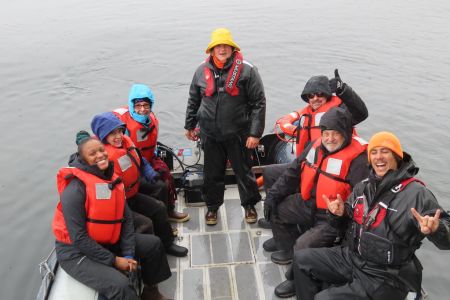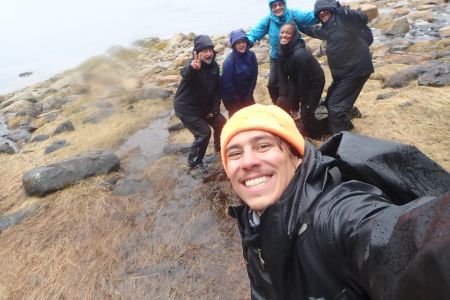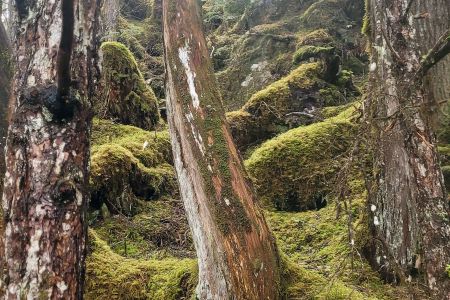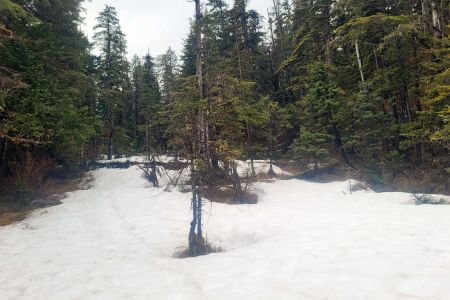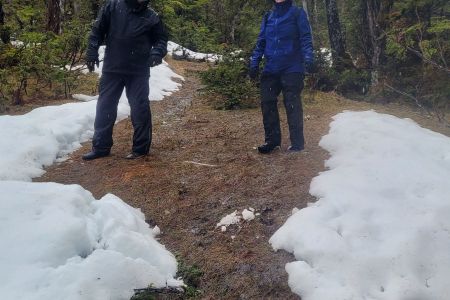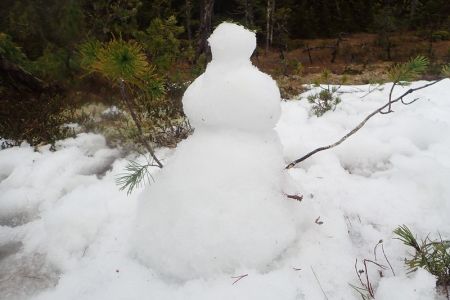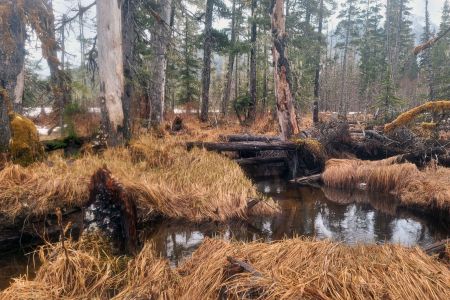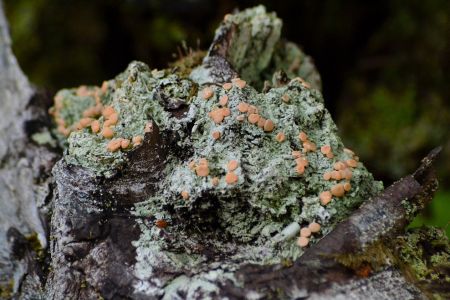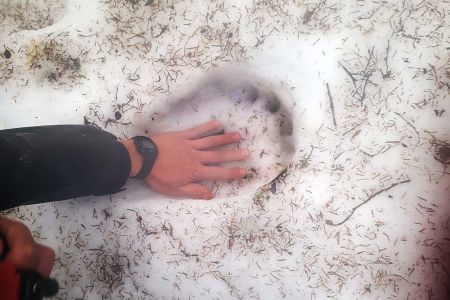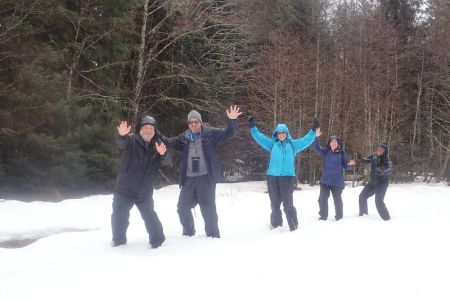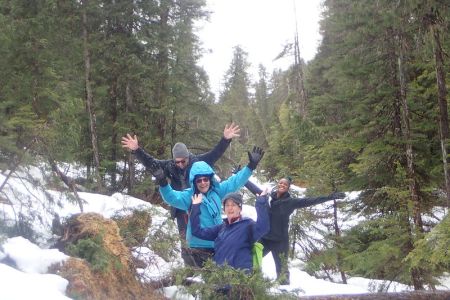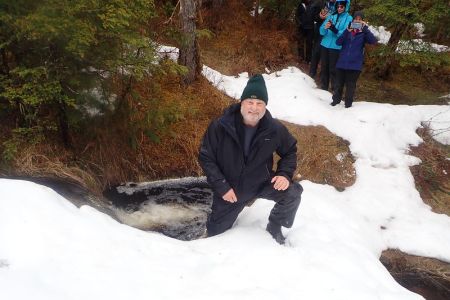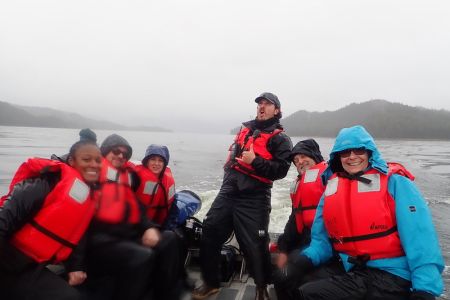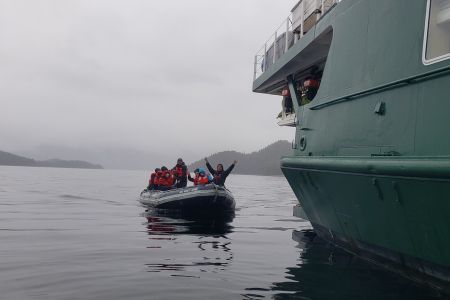
Day 4 (Thursday):
Pavlov Inlet... ?
We awake the morning of the 4th day, and notice we’re not anchored in Pavlov Bay as promised. We are, in fact, still motoring up the straight. We make our way out to the lounge. Out the bow windows, the point of the inlet to Pavlov is in sight, though mostly shrouded in thick clouds and fog and even a bit of snow. The winds are gusty, the boat is pitching wildly, and waves are splashing up onto the foredeck and windows. Brittany comes to the lounge and tells us that the wind is blowing directly into, and funneling up through, Pavlov Bay, and the Captain feels it would be a bad idea to make our way in. He’s decided to turn the boat around and head back to anchor in Seal Bay for a second day. He calls down to ready all the passengers, since turning the boat will push our bow into the wind and it will make things pretty dicey onboard. Karen reveals she’s very susceptible to sea sickness, and does not relish the thought of the upcoming maneuver. The Captain is holding off until Karen has taken some Dramamine, but he can’t wait forever. As we feel the ship buck and jive, Karen’s face turns ashen and she retreats back to her cabin. Eventually we are called down to breakfast, despite the tossing and turning. The lyrics immediately jump into my head: “fellas, it’s too rough to feed ya ”, but by the time we’re going through the buffet line, we’re already in smoother seas and even Karen has joined us for the meal.
Day 4 (Thursday):
Pavlov Inlet... ? “Seal Bay, Part Deux”
It will take us the better part of the morning to get back to Seal Bay, and once we arrive, the weather is clear and sunny, though the water was not quite calm enough for kayaks. So after lunch, Brittany tells us we’ll have an opportunity for a bushwhack around the inlet, or a skiff tour around the bay.
Being gluttons for punishment, we opt for the bushwhack. A quick check of the bulletin board outside Brittany’s office to spy the meeting time, and see that in addition to us, it’s just Bill and Margy signed up. We return to our cabin to don all our warm and waterproof layers, slip into our boots, and then meet Mickie up on the Aft 300 to wrestle into our orange skiff-compatible PFDs. As we’re getting ready, a late addition, Tichelle the ship’s stew manager, joins in. Once we’re all set, Mickie calls down to the fantail so they’re expecting us, and the six of us walk down to pile into the skiff, and head for a small patch of snow on the bank.
Mickie and the Muskeg
As we slide off the skiff onto firm ground, we find about 20 feet of rocky beach, before the terrain heads uphill, beside a small waterfall. Once up on the ridge above the shore, we were in an immense snow-covered muskeg, surrounded by a vast forest and tall mountains beyond.
The snow makes for some tough trekking. Still a good 2- to 3-feet deep or more in some places, it’s also now warmed up and soft enough that heavy weight will fall right through. It seems every 3rd or 4th step we’re disappearing up to our thighs, causing lots of laughter. This is the first time Tichelle has been in snow, so she immediately builds a small snowman. A short few steps further and there’s a grand clearing perfect for snow angels. The muskeg is huge, seemingly the joining place for several small streams and collecting pool for runoff, and the trees, though sparse in most areas within, stand tall and strong. The openness of the area allows us spectacular views of the mountains, as well as several eagles soaring high overhead. We discover lots of sphagnum moss, which is affectionately known as “nature’s sponge” because it apparently grows with large pockets in it’s cellular structure that, after a rainy season, can fill up with water. Mickie picks up a small handful and squeezes, producing nearly a pint of relatively clean water. Handy survival knowledge, if we ever find ourselves stranded in the Alaskan wilderness.
A little further on, and we find a trove of century moss, which grows in spindly shoots, with distinct shoulders visible where it had been dormant for the winter. By counting the shoulders, you can tell how many years the plant has been alive. Mickie counts the shoulders on one shoot we find just hanging casually on the trunk of a fallen tree, and comes up with 25 years. This one little moss plant has been around as long as Margaret and I have been married. Around another fallen tree we find some “fairy barf” lichen, which grows in the shade as a soft green pelt with small pink and grey nodules (hence the name). We also find an entire grove of our old friend Devil's Club, and decide to give it a wide berth as we make our way through the bog.
Still a bit deeper in, and we’re finally at the outer edge of the muskeg. The trees become more dense as we head out of the muskeg and into the forest proper. We shift to walking in a narrow stream to avoid walking on the soft snow, though the creekbed turns out to be somewhat slippery with moss. Soon we stumble upon a bear’s paw print in the snow, and compare it’s size to our own hands, which it absolutely dwarfs.
When we finally break out of the timberline, we find ourselves on a wide riverbed. It happens to be the very same riverbed we had walked yesterday morning, exactly where Mickie had planned to come out. Because of the tide, the place looks both familiar and different. Large tidepools had formed along the center of the inlet that had been bone dry when we’d visited before, and it’s easy to see how salmon would’ve gotten caught as the water receded.
A quick call on the radio, and the skiff is on it’s way to pick us up. Feeling tired and humbled, but accomplished, once we’re back on the boat we head back to our cabin to doff our layers and freshen up a bit. Then it’s out to the lounge for some well-deserved drinks and conversation with the other passengers who had been on the skiff tours.
The Best 6 o'clock News ever
It had been a wonderful day, despite not making it over to Pavlov. But when Brittany comes up for the 6 o’clock news, she brings some exciting news. Apparently feeling somewhat chagrined that we had to spend a second day in Seal Bay, she and the Expedition crew had been on the phone to the park rangers most of the day and arranged for us to spend an additional full day in Glacier Bay. Now, to understand the gravity of this news, you must first understand that, as a pristine protected wilderness area, access to Glacier Bay National Park is highly limited. We hear told that only one of the large cruise ships, and two or three ships the size of the Wilderness Explorer get to enter the park a day. So the fact that we get to spend two days in the park is huge. A lot of it likely has to do with the fact that the boat we originally booked was cancelled, but now we’re feeling blessed that we have essentially been able to mix the best of both itineraries.
It will take all night to motor up to Glacier, and as we head down to dinner the crew is already pulling anchor to leave Seal Bay. Conversation around the table, and in the lounge after dinner, is all about the excitement in the air. We finally retire to our cabin, and fall asleep to the engines as we head north.

